Garlic Scape Pesto
 Garlic
scapes are the sprouts of young garlic plants, a thin, green stalk
that curls above the ground and is more tender and sweeter than
the cloves that lie below. But there’s a reason the scape is not
widely known, and that is because it must be picked within the
first two weeks that it breaks the surface of the soil. In
our area (Long Island) they're available in June. If you
wait too long and the stalk straightens out, the scapes become
tough and unappetizing. Garlic
scapes are the sprouts of young garlic plants, a thin, green stalk
that curls above the ground and is more tender and sweeter than
the cloves that lie below. But there’s a reason the scape is not
widely known, and that is because it must be picked within the
first two weeks that it breaks the surface of the soil. In
our area (Long Island) they're available in June. If you
wait too long and the stalk straightens out, the scapes become
tough and unappetizing.
Garlic scapes can also be used in salads, omelets and elsewhere as one would use young green onions. This is how they are usually used by my daughter Sharon who runs an organic restaurant—The Bees Knees—in Morrisville, Vermont. This recipe has been adapted from several sources including my own experimentation. Since pesto is more art than science, it helps if you taste and adjust as you go along. Most chefs insist that freshly grated cheese must always be used. However, my experience is that if you are over 65, so many of your taste and olfactory nerves are busted that the freshness of the grating seems to be largely irrelevant. And if you are lazy, store bought grated cheese seems to work just fine. WARNING—parmesan cheese can be very high is sodium content, ranging from 1500 to 4000 mg per cup! The current recommendation is to consume less than 2,400 milligrams of sodium a day. Check the labeling of the brand of cheese you buy! (One cup contains 48 teaspoons, the unit sometimes used in labeling parmesan cheese sodium content.) There is no need to add extra salt to this pesto. Do not use salt in preparing pasta. I once used parmesan cheese with a salt content at the high end of the range, and found the pesto much too salty. |
- ½ cup garlic scapes, finely chopped (pictured above is the quantity of scapes you need to get about ½ cup of chopped scapes)
- 4 tablespoons lemon juice
- ~ ½-¾ cup olive oil
- ~ 2-3 cups grated parmesan cheese
Put garlic scapes and lemon juice in the bowl of food processor using a steel blade, and process until scapes are very finely chopped. With food processor running, add oil and process for two to three minutes. Add about ¼ of the cheese and process for another two minutes. Add the remainder of the cheese and process for another two to three minutes. You may use some of the pasta water to adjust the consistency of the pesto.
Serve tossed with hot pasta.
Serves four.
Page revised: 26 Jul 2013